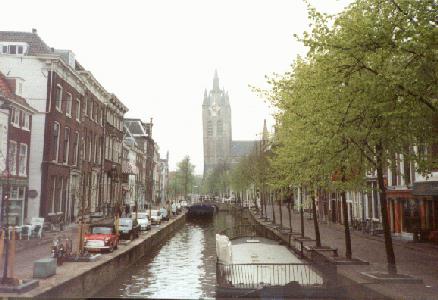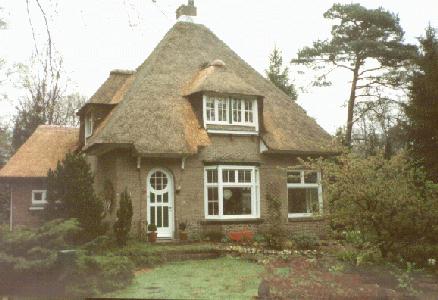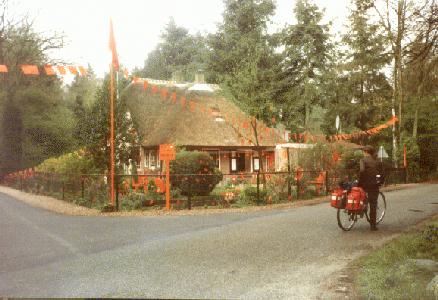KOBLENZ TO LELYSTAD
We intended to train it to Cologne
(I just HAD to see the cathedral) then Arnhem, and catch up a
few days that way. Russell would also catch the train next day
(Saturday) as he was due to fly out of Amsterdam on Friday morning.
We noticed the train fare became pretty steep, now that the excursion
fare was shared between two instead of amongst five! I believe
also the fact that we were crossing the international border between
Germany and the Netherlands added to the price.
At Cologne we left our panniers in
a locker, and locked our bikes up outside the station. The cathedral
is immediately opposite the station, so finding it was no problem,
we just had to fight our way through the crowds. This seemed
to be a repetition of history - the relics of the Magi drew so
many pilgrims in the middle ages that they had to build a huge
church just to accommodate them all at mass.
The structure itself is a monument
to the stonemason's art - to me it seemed as if the whole thing
had been crocheted in stone, it was all so intricate. It is a
shame that hundreds of years of coal-burning fires and acid rain
have left their mark in the blackened stones and crumbling sculptures.
Efforts are being made to clean and restore the stonework, but
I am afraid it is too late - you can see it crumbling before your
very eyes. The inside is dark, but awesome, with the lower tier
of stained glass windows standing 17 metres high.
We spent about three hours in and
around the cathedral, then boarded the next train for Arnhem.
Netherlands, here we come!
The weather had deteriorated badly
by the time we reached Arnhem. We called in to the money exchange/hotel
booking agency (I can't remember what it was called) on the way
out of the station, in the hope of getting a bed in town, but
the only accommodation available was two beds in a shared dorm
at the youth hostel. It was a four-bed dorm, and the other occupants
were "an older German couple". We accepted the hostel
beds, then made our way to "Alteveer" through the steady
rain.
We parked our bikes in the large,
dry bikeshed, and pushed wearily through the doors to reception.
Denis cheered up the minute we crossed the threshold, for there,
immediately opposite the reception desk was a real live dinky
di bar, all done up like an English pub! He had been afraid,
I think, that he would be confined to quarters because of the
rain, and an evening of broken German conversation with our room-mates
wasn't particularly appealing. He needn't have worried as Herbert
and Wilburga were nowhere in sight, and we didn't meet them until
the next morning. They were a lovely couple, and we'd really
like to see them again.
Well, Arnhem youth hostel Alteveer
really rocked on the evening of Saturday 26/4! Some all-female
hockey team was having their annual weekend away, and they really
knew how to enjoy themselves. Denis was in great demand as a
dance partner as he was the only male present on the customers'
side of the bar (there had been some others earlier, but they
quietly melted away as the ladies really started to party!) He
had a ball!
Next morning it was still raining.
We were to meet yet another EB connection, Marten Toxopeus, on
the Oostvaardersdijk between Lelystad and Muiderberg on the morning
of 1 May, which gave us 4 days to get to Lelystad (yes, Lelystad
;-)) As we no longer had time to do our scheduled trip through
North Holland via Rotterdam and the Hoek van Holland, and we didn't
fancy riding too far in the rain, we decided to stay at the hostel
in Arnhem for the next two nights.

The canals of Delft
We spent the day on trains, making
our way via Utrecht and Rotterdam to Delft, home of the beautiful,
and mighty expensive, blue and white porcelain. Beware of ripoffs!
"Hand decorated" does not mean the same thing as "Hand
painted". You pay a lot for the genuine article, but some
of the cheaper, mass produced items are quite tasteful. It was
a dull day, and Delft itself looked rather dull, but I'm glad
we don't have canals in Canberra - I can't imagine reverse parking
a car beside one! Hanging around railway stations can also present
touristic experiences - Denis and I both enjoyed the snacks we
bought from the automatieks - and the kroketten were nearly as
good as the ones made by our Dutch mates back home.
We hoped for a clear day on Monday
28/4, but it was not to be. We spent the morning at the VVV trying
to book accommodation in or near Amsterdam for our last 3 nights
in the Netherlands. We were completely out of luck. It would
be the weekend following Queen's Day, and it seemed like everyone
had decided to extend the public holiday from the Wednesday to
the next Monday (another public holiday, Liberation Day). Denis
was doing his 17.00 panic, and it was only 11.00!! We settled
for one night in Muiderberg, as we were already going there, and
two nights in Zwanenburg, which is not too far from Schiphol airport,
on the way to Haarlem. As it was still too wet to do any decent
outdoor sightseeing, we went shopping instead :-)
Tuesday 29/4 was still wet, but it
was time to mount up and move on. Today we were headed for Apeldoorn
and the Paleis het Loo, and then on to Epe where we were booked
in to a B&B for the night. We followed the cycle path north
through the Hoge Veluwe National Park, and that's where we came
across our one and only "wild rooster". We were riding
along in the drizzle through the lightly forested landscape when
we passed one of those <exclamation mark in a red triangle>
warning signs. The words underneath said "Wild rooster".
Now, I've seen wild pigs, and they can get pretty mean, but what
should one expect from a wild rooster - to be crowed to death?
Or perhaps it was a monstrous fighting cock, with giant spurs
on its feet, and it would fly onto my shoulder and pierce my jugular
vein, or peck my eyes out? We kept a wary eye open for anything
untoward, but nothing leapt in to view - we couldn't even see
any chickens. We realised we were headed in the wrong direction
and turned around, and there, 100 metres back down the path was
another sign warning of the wild rooster - it must have had a
very limited territory. Just after we passed the sign (second
time), we crossed a cattle grid (for the second time). We wondered
why they didn't have a warning sign for .... oh, we had been reading
the sign in English, but it was written in Dutch, oops!

A pretty thatched house in Apeldoorn
We were pretty sodden by the time
we reached Paleis het Loo on the northern edge of Apeldoorn, around
35k from Arnhem. The palace was the home of William of Orange
and his English wife Mary, who were later invited to England to
reign as joint monarchs after the Brits decided James II was a
bit too Popish for their liking. The building is furnished in
grand style, and is open as a museum for public inspection - you
can wander around at your own pace, or take a guided tour (in
Dutch). We struck up a conversation with a young woman who has
been trying to locate some long-lost relatives in Australia.
I promised to help, but have had no luck so far :-(
We left Apeldoorn and continued to
Epe, about 15k to the north. The cycle paths are well marked,
and the streetpoles that are numbered to correspond to points
on the cyclemaps provide reassurance. The map of Epe at the southern
entrance to the town has not been updated for a while - it did
not show the street we were looking for, and you know, we were
getting close to THAT time of day =:-o
I asked for directions at a greengrocer's
- the proprietors didn't speak English, but their customer did,
and obviously knew the town well, too. She was well into her
seventies, and her English was fairly broken (but 3000 % better
than my Dutch!), but her instructions were spot on, and we found
our way to Schutteshof without much trouble.
Schutteshof is a B&B run as a
sideline to the family farm. Mijnheer Schutte is a large man,
and when we arrived he was wearing the biggest pair of clogs I
have ever seen in my life! The building is a traditional style
Dutch farm house, complete with thatched roof, which has been
extended on the inside to include a couple of double rooms, a
family room, and a self-contained apartment for longer stays.
We had tea in a pub we had passed
on the way, only to find it the headquarters of a local cycling
club. Tuesday night was obviously time-trial night. The timekeeper
was having a coffee with the bunch when we walked in, but he went
home not long after, leaving the stragglers to clock themselves
in.
I ordered a ham and cheese pancake
for dinner, and couldn't believe it when the waiter brought over
the apple syrup and powdered sugar to pour over the top. My new
Dutch internet friends later told me this was normal practice,
but I'm afraid I rejected the experience.
The next day was Queen's Day, 30
April, and the whole population of the Netherlands celebrates
in some way. Mijnheer Schutte gave us a map of Epe, with directions
to the road to Elburg. "You will be on the right road if
you pass an orange house", he told us. Well we were, and
we did - orange streamers, orange flags, orange flowers everywhere.
The sign out the front was a bit superfluous - Tijd voor oranje
(time for orange), it read.

Decorations for Queen's Day, in Epe
Just past the orange house we were
picked up and pulled along by a friendly group of racing cyclists
out for a morning training session. Even though we were drafting,
I found the exertion a bit too much, and had to drop off the back
after a couple of kilometers. We had missed our preferred turnoff
in the excitement, but the adrenalin rush kept us buoyed up for
the next couple of hours :-)
Cycling in this part of the Netherlands
is pretty simple. You just need to know the general direction
you're headed, then follow the signs on the cycle paths. At Elburg
we saw our first traditional thatched windmill, then we crossed
the bridge into the Flevoland polder. The polders are quite amazing,
stretching flat from horizon to horizon. Because the reclaimed
land has an even depth of soil right across, trees planted simultaneously
all display the same growth rate, so it looks as if some giant
gardener has been out with the hedge clippers, trimming the trees
to an even height.
At one point we saw a long flash
of red in the distance. I thought it was a plastic fence, but
Denis insisted it was tulips. He was right, but unfortunately
that was the closest we got to any of the tulip fields I had so
been looking forward to. Maybe next time ...
The 12 or so kilometers between Elburg
and Dronten was fairly slow, as we struck a rather stiff head
wind. That's the one trouble with riding on the polder - there
is nothing to break the wind - you just grit your teeth and struggle
on. It must be great if you're travelling in an easterly direction!
Dronten to Lelystad was a lot easier,
as there is a wood running alongside the cyclepath. The trees
create interest, and form an serviceable windbreak as well. We
were due to meet Ina and Peng, friends of Marten's, at our lodging
in Lelystadhaven at 15.00. I was a bit worried about navigating
through Lelystad itself, as we had always come unstuck in the
urban areas. There was no problem however, as the way to the harbour
was signposted right from the southern outskirts of town. As
we approached the harbour from the polder level it was strange
to see the boats all floating at anchor 5 metres above us!
We made it to "De Lange Jammer"
with about half an hour to spare, so we had time for a quiet beer
in the bar before Ina and Peng arrived. I had corresponded with
Ina via e-mail, and had spoken to her on the 'phone, but I had
no idea what she looked like. My only clue was that Peng was
a New Zealander. It was obvious who they were when they walked
in - Peng's black hair kind of gave him away! I guess my Australian
flag tacked to the front of my barbag kind of gave us away too
;-)
Ina and Peng took us in tow back towards Lelystad proper. We did a tour of the leftovers of the Queen's Day markets, had coffee at their place, then went out for tea. After tea they rode back to the harbour with us. Ina had told us something of the intricacies of the Lelystad cyclepaths, how some roads may be used, and others are forbidden to bicycles. I'm glad they were with us, because, even with local knowledge, we became flummoxed a number of times. Luckily it was a perfect night to be out riding.